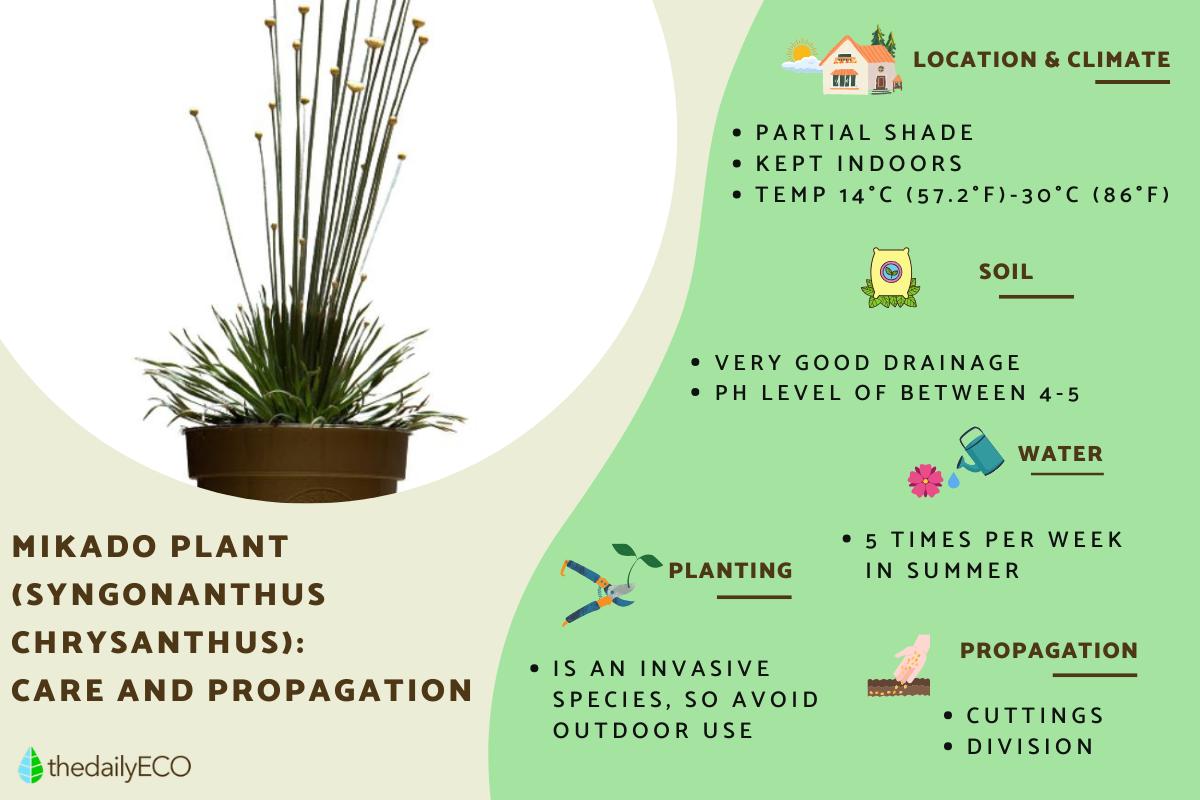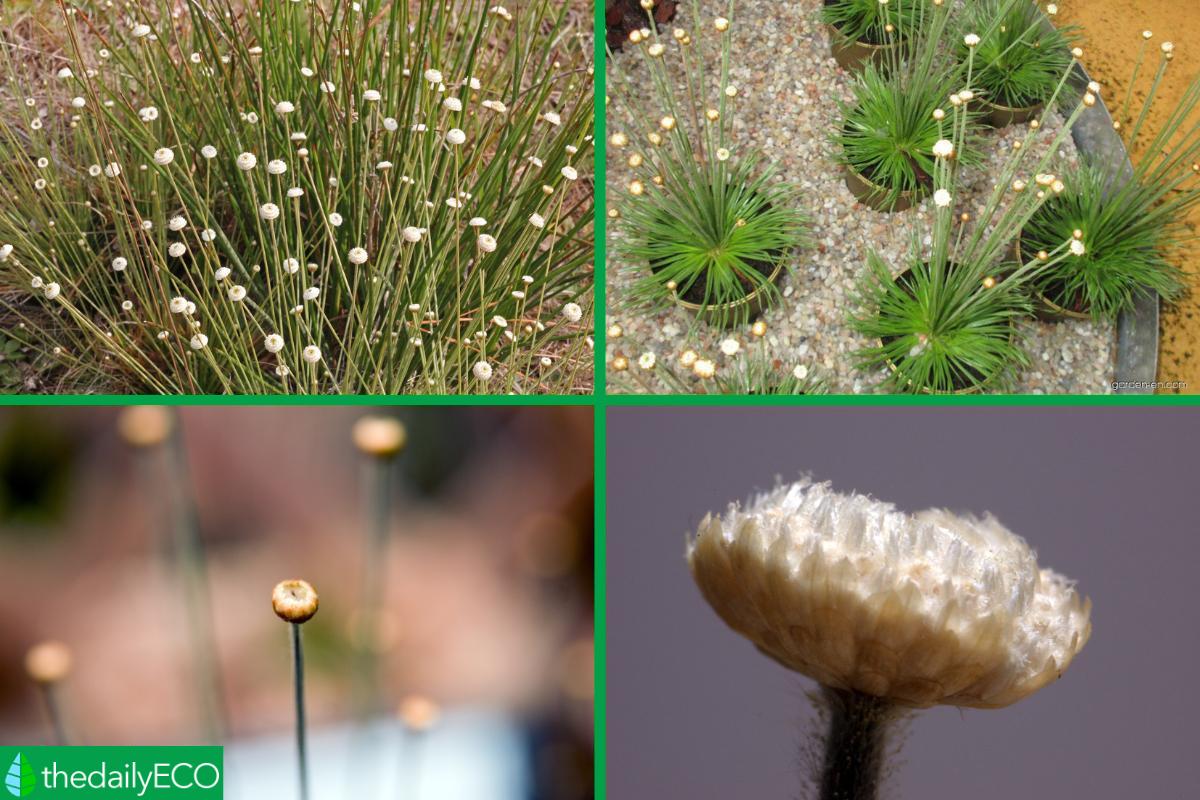Mikado Plant Care Guide (Syngonanthus chrysanthus)


With its unique appearance, the mikado plant is a beautiful addition to many indoor spaces. It is a cultivar of Syngonanthus chrysanthus, specifically Syngonanthus chrysanthus ‘Mikado’. It is an easy-to-grow plant which can thrive in various conditions. Its distinct form means it can be a very special addition to many arrangements, as well as being used as a plant on its own. While it will also thrive in the outdoors, we recommend you do not plant it outside. Native to Central and South America, it can be an invasive plant and form dense thickets around other plants. This can be dangerous for local ecosystems.
Learn more with thedailyECO as we provide a complete mikado plant care guide for Syngonanthus chrysanthus.
Characteristics of the mikado plant
Syngonanthus chrysanthus 'Mikado' is the taxonomic name of the commonly known mikado plant or kokedama mikado. It is a plant native to the Americas, particularly the tropical areas of Brazil. It belongs to the genus Syngonanthus which has more than 200 species, all of which are characterized by being from an aquatic environment
It receives its name from the Mikado, a children's game consisting of a series of long, thin wooden sticks. It is sometimes known as pick-up sticks. These sticks are strongly reminiscent of the particular shape of this plant, with its long stems that are completely straight and devoid of leaves or branches on the sides.
It has a rosette of fine green leaves, from which its characteristic inflorescences sprout at the top. These present as long stems topped by a small white or gold floral bud before opening. The flower stems reach a height of between 25 and 30 cm. The rosette is about 8 cm in diameter, making it a small plant that we can place practically anywhere.
Learn more about different types of aquatic plants with our article on different types of aquatic biomes.
Where to place a mikado plant
As with many species, the mikado plant's status as a tropical plant tells us a lot about its needs in terms of light and temperature. With this in mind, we need to consider the following when deciding where to place a mikado plant:
- In its natural habitat: being a small plant, it is found in areas with a lot of light but covered under the rest of the taller vegetation, so it needs very illuminated areas but always protected from direct sun.
- Indoors: the ideal would be to place it in a room with lots of light but away from windows. If there is no choice but to place it next to a window or light source, it will be necessary to use a light curtain that filters the light, providing it with the UB it needs without damaging it.
The mikado can also be grown outdoors, but only in areas with a temperate climate that is very similar to the tropical one. As stated in the introduction, it can be an invasive species, so it is best kept away from the outside and is most commonly grown inside the home in a pot.
Its ideal temperature is between 19°C (66.2°F) and 22°C (71.6°F), tolerating cold up to 14°C (57.2°F) and heat up to 30°C (86°F). Incorrect temperature is its main weakness and one of the most important points when it comes to caring for the mikado is to create the correct ambient temperature.

Watering the mikado plant
In addition to temperature, the other most important to aspect when caring for the mikado plant is watering and humidity. Tropical climates are characterized by stable temperatures and high humidity levels. These need to be replicated as best we can in the home to ensure the health of a Syngonanthus chrysanthus.
The mikado must be watered often to maintain a constant level of humidity in the substrate, as it is an aquatic species from swampy areas. This does not mean that we should flood the substrate. Although the mikado is more resistant to these conditions, they could damage it in the long run. Always keep the soil moist, either with a drip irrigation system or by watering manually about 5 times a week. This is especially important in the warm months.
The plant also requires high environmental humidity. We can emulate this either by spraying water on its rosette once or twice a day, or by placing the pot on a small bed of stones and pebbles partially submerged in water. In this way, humidity will rise through evaporation, seeping through the drainage holes and enveloping the plant.
Learn about another plant that benefits from a pebble tray with our guide to caring for caladium plants.
Substrate for the mikado plant
As for the substrate, the mikado plant is not excessively demanding. The most important point is that the soil should be slightly acidic with a pH of between 4 and 5. If the water in your area is very rich in calcium, it is likely that it will end up altering the pH of the substrate.
If you see symptoms that the substrate has become too alkaline, it might have yellow leaves or stems, transplant it and water it with distilled water or water that has sat for 24 hours before use. In this way, the salts will settle at the bottom and if you water without using all the water you will avoid adding these elements to the plant's soil.
Learn more about changing the pH of plant soil with our article on chelated iron for plants.
Mikado plant leaves are turning yellow
If the plant seems to dry out or shows signs of yellowing, it is most likely due to:
- Lack of irrigation and humidity: in this case, simply gradually increase irrigation and spraying.
- The substrate has lost its acidity: you will have to transplant it to a new pot with a specific substrate for acidophilic plants and stop watering it with tap water.
Learn more about plant substrate with our articles on how to make worm castings at home and whether perlite or vermicultie is better.
Mikado plant propagation
If you want to reproduce the mikado plant, you can do so with the following options:
- Cuttings: take a cutting of the stem and place it in water. Wait until the roots start to grow, something which can take between 2 to 4 weeks.
- Division: take the plant by the roots and separate some of them from the main plant with the stems attached. Place them in new soil and wait for them to take root. This should be quicker than cuttings.
Learn more about caring for and propagating plants at home with our complete Kalanchoe farinacea care guide.
If you want to read similar articles to Mikado Plant Care Guide (Syngonanthus chrysanthus), we recommend you visit our Plant care and cultivation category.






